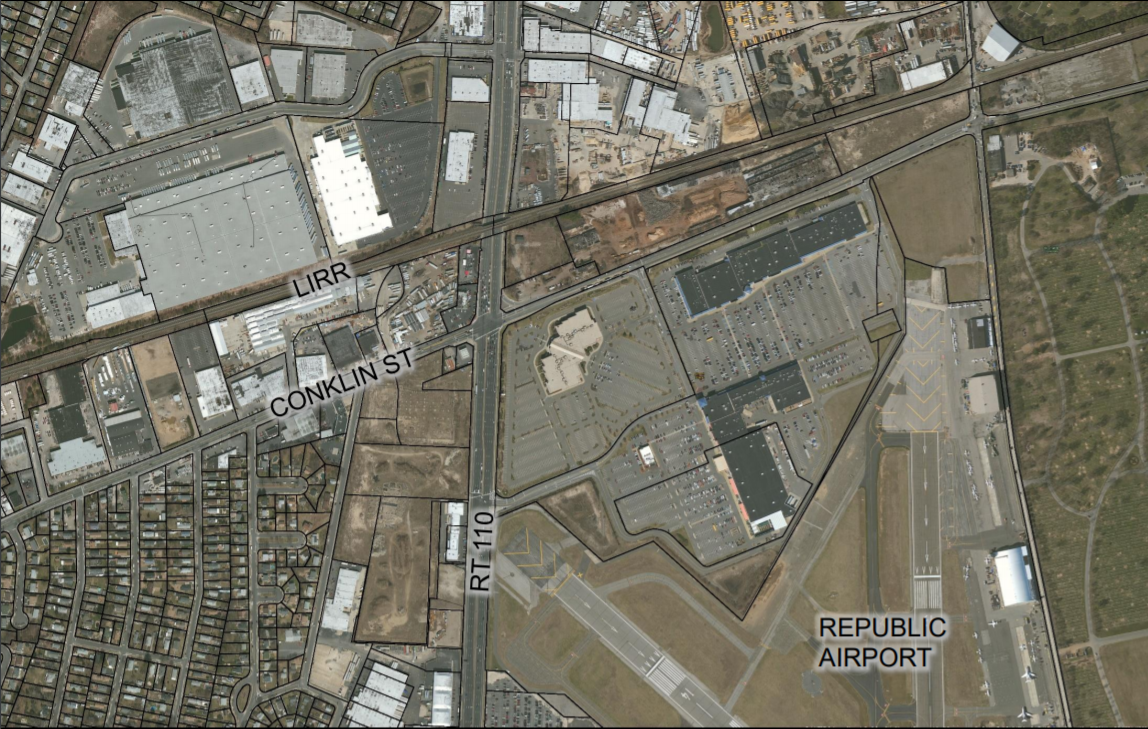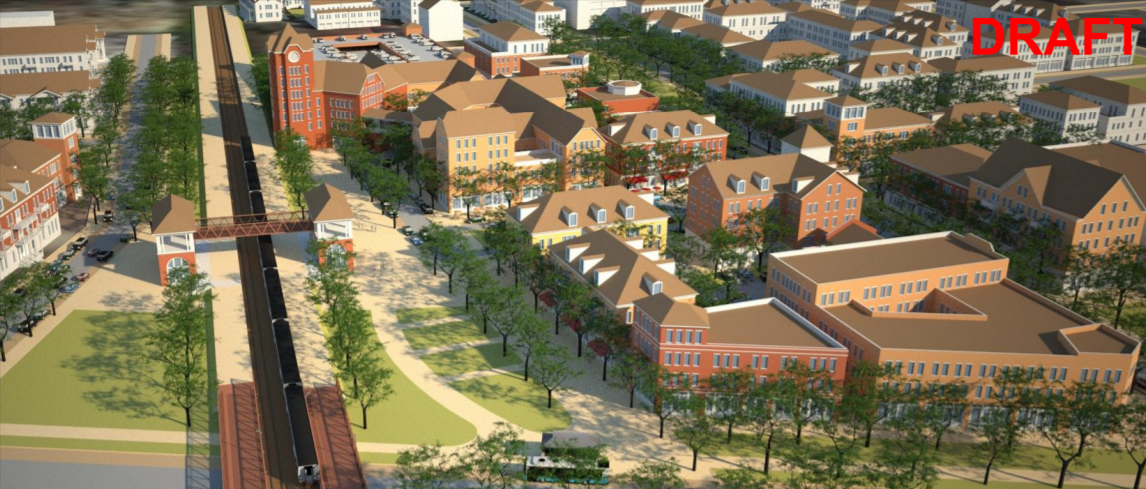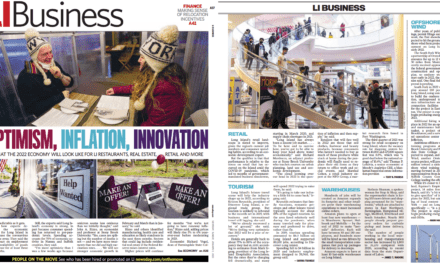The following was written exclusively for The Foggiest Idea, and published on July 12th, 2018. Interested in supporting The Foggiest Idea’s award-winning reporting and analysis? Click here.
By Richard Murdocco
The area bounded by Conklin Street and Broadhollow Road in the unincorporated hamlet of East Farmingdale isn’t especially attractive.
On a sweltering summer day, it all looks like an endless sea of asphalt straddling Republic Airport, occasionally broken by islands of 20th Century retail: an Applebee’s, a multiplex that faces direct competition from another cinema close by, as well as a Stew Leonard’s, the experiential grocery story with animatronic farm animals and apple cider donuts that opened with great bombast in 2013. To add to the ambiance, a steaming mulch mound towers directly north of the property across the LIRR railroad tracks. Sometimes, the mulch is ablaze – casting a foul pall into the air.
Since 2007, this unappealing location has been in the crosshairs of New York State and the Town of Babylon to be further developed. It may finally be getting its day.
In June 2018, Newsday’s Jesse Coburn reported that the Town is considering rezoning the 109-acre swath with a proposed form-based code that would allow for a sizable mixed-use center. According to the Draft Environmental Impact Statement (DEIS) on the rezoning, the new rules for the area could allow for a maximum of 2,681 residential units and 3.1 million gross square feet of potential building space. At full build-out, these allowances could, in turn, produce a maximum of 4,402 new residents and $612 million in construction in the hamlet.
Completed in May, the DEIS is the culmination of a long-running planning process that has only recently captured larger attention. In April 2018, the town released the results of a five-day community visioning process held earlier in the year when residents gave their wish list for the area, which included more mixed-use development, walkways, pocket parks, greenery and more.
But the redevelopment effort is lagging far behind. In February 2017, Newsday reported that the proposed code changes for the East Farmingdale site would likely go before the town board for approval by that fall. Now nearly a year has passed and Babylon still hasn’t scheduled public hearings or town meetings on the rezoning ideas.
Meanwhile, there has been growing pushback against the very notion of redeveloping this unpleasant property. Fueled by the DEIS’s findings, local residents have been flocking to social media pages and Babylon’s town hall to express their concerns.
“Everyone living and raising a family in our town will suffer from the development of our town,” one angry resident wrote on Residents of East Farmingdale Civic Association’s Facebook page. “I would never ever live in a city or Queens. People have moved here to live in a nice environment and these developments are completely destroying everything we have here,” this resident continued, going on to espouse family values and deride what they called “city lifestyles.”
The backlash has been so swift that the Town is assembling an implementation committee to work on the project. Its members will be drawn from civic groups and residents, with nary a stakeholder or builder in sight.
To allow for the group to do it’s work, the Town decided to further delay the rezoning further in July. “The town board is not happy with the way the process went down,” Babylon town supervisor Rich Schaffer said during a July town board meeting when the topic came up. “I don’t believe we were served well.”
“We want to make sure that East Farmingdale has their first say as to what should be done or what should not be done there,” Schaffer told Newsday afterwards. “Then the general town will be able to take a look at it.”
Amy Pfeiffer, Babylon’s director of downtown revitalization, has been in the planning business in the New York metro area for roughly 20 years. She wasn’t surprised by the negative reaction sparked by Newsday’s story about the DEIS report.
“When we do planning work in the State of New York, the process is often confusing,” Pfeiffer told The Foggiest Idea, adding that a project’s specifics are often hard to figure out and the extent of the New York State Environmental Quality Review Act or SEQRA isn’t clearly spelled out.
Pfeiffer noted this isn’t the first time that policymakers have tried to revamp this East Farmingdale parcel. One problem they face is that redevelopment is heavily constrained by the Republic Airport’s flight paths and the Federal Aviation Administration’s guidelines for safe development near airports. Pfeiffer told TFI the Town’s priority is to entice the LIRR to reopen the nearby Republic station, which closed in the mid-1980’s and located right off of the railroad’s main line, and clean up the steaming pile of mulch. Currently, the site where the mound sits is leased to a private business by the state.
“It’s a terrible detriment,” she said. “We should do something nice there.”
While the bombastic numbers cited by the document are sure to send some development-wary residents into a frenzy, cooler heads should realize that the DEIS projections are merely referring to the full-build-out. The figures are more like a worst-case scenario.
Outside the social media echo chamber, not everyone in the area hates the concept of revitalization. Thomas Joseph Jr., the leader of the Residents of East Farmingdale Civic Association, has been working on rezoning the area since 2009.
“I agree with most of the project,” he told TFI. “However, there are aspects I don’t agree with.” He cited the potential allowance of structures taller than three stories and the expected increase in traffic, as well as the rezoning’s overall scope. “It is larger than anticipated,” Joseph said. “The planning company spearheaded the design, and it’s simply too big for our community.”
According to Pfeiffer, Babylon is just laying the groundwork for future growth, and this step is one of many in what will likely be a long process.
“This is all purely conceptual at this point,” she said, suggesting that it could take 25 years to finish. “These numbers shouldn’t be taken as gospel.”
A veteran planner, she explained how she viewed the impact statement’s estimates. “I like to diligently do an EIS from max build-out,” Pfeiffer said. “It gives us a good sense of what the design should look like.”
What ties the project together is increasing the site’s links to transit through both the reopened LIRR station and Suffolk County’s long-proposed—and yet-to-be-funded—Connect Long Island concept, which calls for a $35-million rapid-transit system not only on Route 110 but eventually along the Sagtikos/Sunken Meadow Parkway and Nicolls Road further east. Having mixed-use development at the East Farmingdale location would make it easier to justify the ample investment needed to pull it all off.
“I don’t think the town will take further action aside from rezoning the site,” Pfeiffer observed. After the town does their part, area residents realize that compromises will have to be made.
“I know there will be concessions,” Joseph said. “As long as we come to an agreement, it should work out well. I am optimistic and reserving my judgement.”
From the Town’s perspective, Pfeiffer conceded that the site’s current condition leaves a lot to be desired.
“We can do better than what’s there, but it’s a tricky project,” she said. “Our staff has to be careful and do it right. It’s not like it is out east, where every property is a horse farm.”
Meanwhile as the town and residents grapple with what to do next, the mulch pile steams in the heat and the asphalt parking lots bake in the sun.
Richard Murdocco is an award-winning columnist and adjunct professor in Stony Brook University’s public policy graduate program. He regularly writes and speaks about Long Island’s real estate development issues. More of his views can be found on thefoggiestidea.org or follow him on Twitter @thefoggiestidea. You can email Murdocco at Rich@TheFoggiestIdea.org.














The ends don’t necessarily justify the means here. Building out a parcel to justify building a mass transit network doesn’t justify either. Obviously mixed use is needed, obviously not to the extreme worst case scenario presented but I think that interest in groundwater quality and quantity should be considered here…and actually focus on a downtown. This is no downtown.
Level the Fairchild buildings and spread the mulch and allow a piece of Long Island to return to nature. Stop the greed. Stop this ridiculous transit – oriented nonsense and the mimicking of outdated cliches of Feet to the Street & let’s keep millennials here with affordable (NOT) micro-sized studio apartments for $2350 a month plus electric and rental insurance, and let them take the train to grocery shop….a real joke. The trains are a disaster and so is this idea. Floating Zones are back back door deals with vulnerable mayors and Supervisors and the Mafia IDA’s. Stop destroying the last of the open spaces and tell the greedy developers to get off Long Island and build in Nevada.